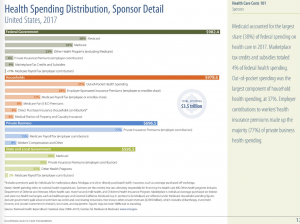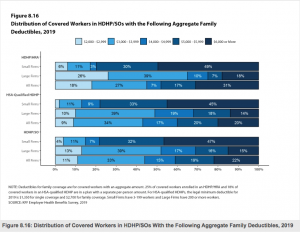Individuals and families will spend about a trillion dollars on healthcare costs this year.
Most of those dollars pay for out-of-pocket costs and your share of employer-sponsored health insurance costs.

For those with employer-sponsored health insurance, annual premiums in 2020 averaged $7,470 for individuals; $21,342 for families.
Average premiums went up 4% this year, continuing the long-term trend of healthcare inflation significantly exceeding overall inflation.
Over the last five years, premiums increased 22%, more than twice the overall inflation rate (10%).
Then there’s out of pocket costs.
Most families with high deductible plans will have to cough up (no pun intended) more than $4,000 before their insurance plan starts paying.

What does this mean for you?
Every year, more and more of your income goes to healthcare.



Joe, Thanks as always for applying some perspective. Perhaps the graphics answer these questions (they are blurry): Where is the source for data revealing the average family out-of-pocket cost for those enrolled in government sponsored (paid for) health care – including medicare? What are those costs (private and government sponsored/supported) as a percentage of annual income for those enrolled in them? Is there a source that might reveal any disproportionality in the “true cost” of health care across income strata?
Hey Steve – thanks for the note, and apologies for the blurred images. sources are KFF, Health Affairs- KFF has a wealth of data. you will have to derive some of the numbers you are looking for.
https://www.kff.org/report-section/ehbs-2019-summary-of-findings/
https://www.kff.org/report-section/ehbs-2019-section-8-high-deductible-health-plans-with-savings-option/#figure87
https://www.healthaffairs.org/doi/full/10.1377/hlthaff.2020.01569
It is crazy to see how much health care and health insurance costs have been rising the past decade. Thank you for putting this together. Super clear and concise.
Thanks Joe – very interesting, as always. What I’m wondering (as well as a lot of others, presumably) is why the ACA has failed to fulfill the promises made by the politicians in enacting it – more and better healthcare at lower cost? What has gone wrong and what can be done about it?
Hello Mike – thanks for the kind words.
Your question is a good one, and requires way more space than I can cover here.
My initial take is to question the premise of your question – reality is 9 million+ more people have coverage today than had it pre-ACA. That – by any measure – is a huge plus. Nonetheless, things would have been even better if 14 more states expanded Medicaid; many deep red states chose not to.
I’ve written extensively on this elsewhere- here are a few sources that might be helpful.
https://www.joepaduda.com/2017/03/17/three-legged-horses-cant-run/
https://www.joepaduda.com/2015/12/21/so-hows-the-aca-doing-part-one/
https://www.joepaduda.com/2015/12/22/hows-the-aca-doing-part-two/
https://fortune.com/2016/10/04/obamacare-exchanges/
Very briefly, the Obama/Senate effort to get Republicans to sign on by excluding a public option, keeping the uninsurance penalty nominal, and dropping any link between reimbursement and treatment effectiveness of meds and procedures was a total failure. Also GOP successfully hamstrung the ACA via subsequent budget maneuverings.
hope this is helpful – be well – Joe